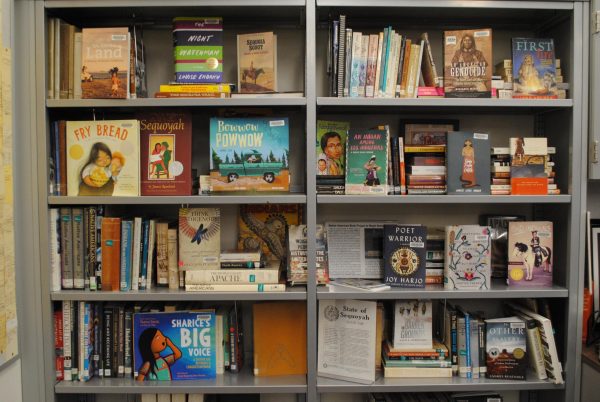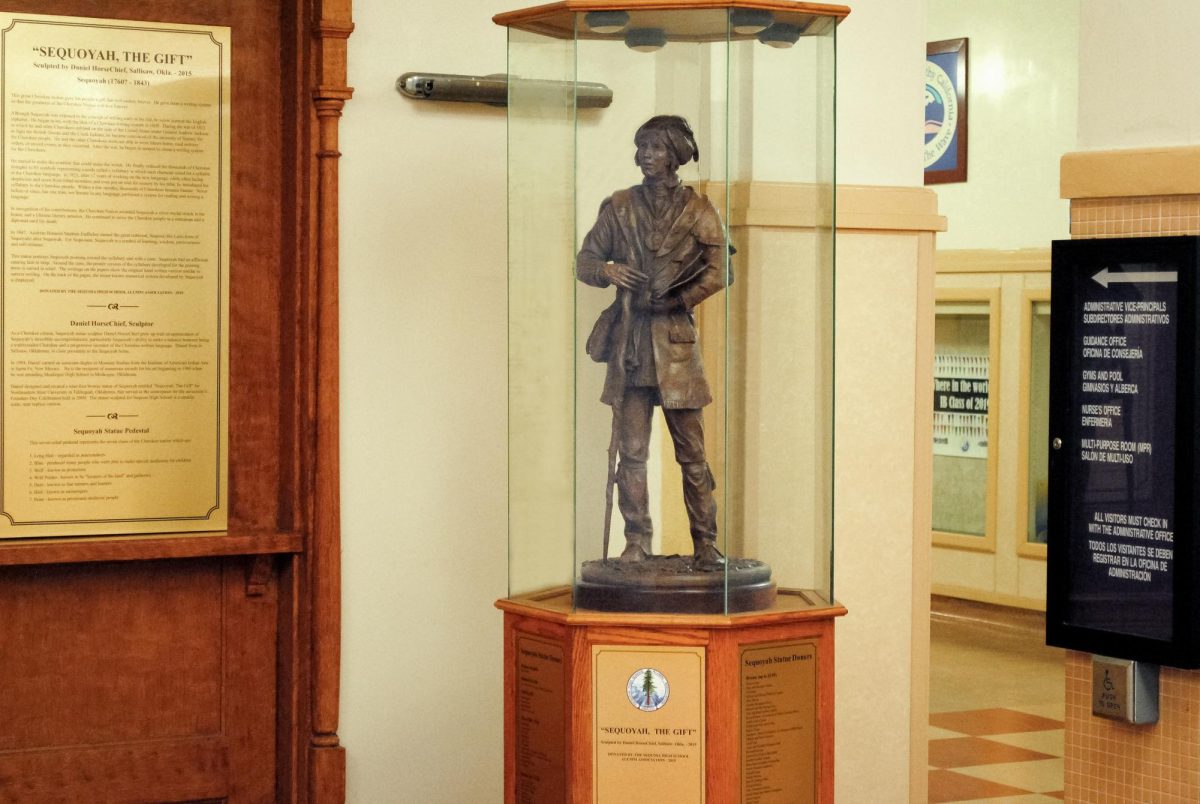Sequoia repainted our walls, redesigned our jerseys and rebranded our mindset, but reminders of our past remain both on campus and within the attitudes of many.
In 2001, following some outcry from administrators, Sequoia officially removed the physical mascot of a Cherokee warrior. However, the issue remained mostly untouched until 2018, when the student-led group Ready 4 Ravens formally requested that “Cherokee” no longer be the team name, proposing the name “Ravens” in its place. Met with harsh pushback from students, current and former alike, the group managed to discuss the change at a school board meeting.
On April 17, 2019, after a fiery meeting between Ready 4 Ravens members and some alumni who were staunchly opposed, the board voted unanimously to change the name to “Ravens.”
“It came down to proving to the board that it mattered to most of the students because I don’t know how many alumni we ever quite got on board,” student leader of Ready 4 Ravens Andrew Mancini said.
How did we get the name?
The name “Sequoia” is plastered across Redwood City. Our school, Sequoia Station and the Sequoia Hotel are some places that share the name. All were named after the redwood tree, which was derived from the Cherokee leader Sequoyah, who invented the written Cherokee language. This connection is how Sequoia chose “Cherokees” as their first mascot.
Impact of Native American Mascots on Native People
The students’ fight was part of a larger battle against mascots that were racist or appropriative of Native Americans. When Stanford University, the college Sequoia was founded to be a feeder school for, removed their “Indians” mascot in 1972, many other institutions and sports teams were challenged to rethink their mascots after the turn of the century.
The Washington Redskins of the National Football League rebranded to the Washington Commanders in 2020 and Major League Baseball’s Cleveland Indians changed their name to the Guardians in 2022. The Edmonton Eskimos of the Canadian Football League became the Edmonton Elks in 2021.
This issue is pressing to activist Lily Joy Winder, who founded the organization People Not Mascots at the end of 2020. Winder notes that change is crucial due to the impact this issue has on Native communities.
“My grandparents were kidnapped from their homes, or simply assimilated, had their hair cut and were beaten for speaking their own language,” Winder said. “It’s really hard to try and rebuild those cultural connections when we still have imagery in our classrooms that is making Native children not want to invest in their cultures.”
While Winder shared her own anecdotes, she also referenced a key study done by the American Psychological Association in 2005.
The study called for the rapid removal of Native American mascots from all organizations, citing the damaging effects of the mascots on Native American peoples. The study found that Native mascots perpetrated offensive stereotypes and didn’t allow Native people to properly display their culture and traditions.
In terms of removing mascots and honoring Native people, Winder asserted that the solution is simply empowering the tribes in question.
“Let those tribes draw those lines for you, and that comes with genuine communication from schools to tribal governments,” Winder said.
Sequoia went nearly 80 years with the Cherokee mascot before contacting the Cherokee nation. John Ummel, who worked closely with administrators attempting to remove the physical mascot in 2001, sent a letter to Chad Smith, the Principal Chief of the Cherokee Nation at the time, asking his opinion on the Cherokee mascot.
Smith argued that change is necessary due to the mascot’s stereotypical portrayal of Native peoples.
“Some mascots depict Indian folks in a very cartoonish way, as merciless savages, vicious people or benign fools,” Smith said.
He compared the situation with Native mascots to a personal experience of his.
“When I was in high school, the cheerleading squad often would have a little sister of one of the cheerleaders, and she may have been five or eight years old. She would dress up just like the big cheerleaders, and she was really cute. She tried to stay up and often couldn’t because she was just the mascot for the cheerleaders,” Smith said. “Indian people are not the little sister, the little brother of everybody else. We should be fundamentally equal.”
The argument to keep native mascots
However, not everyone supports removing Native mascots.
Over 20 years ago, Smith predicted the response of many Sequoia alumni.
“Some alumni cannot accept that these traditions are a negative and stereotypical portrayal of American Indian people,” Smith said in his letter to Ummel.
Dee Eva is a Sequoia alum of the class of 1961 who strongly advocated for keeping the Cherokee name, including speaking against the change at the 2019 board meeting. She claimed that the mascot honored Native Americans.
“I thought that the Cherokee people were very well, positively represented by the mascot that we had,” Eva said. “When we were in school, they did have caricatures in our yearbooks of Indians, and we realized that was not the proper thing to do, so that was stopped.”
However, it appears that this belief is more common in older generations, many of whom are a part of the Alumni Association. Eva agreed and noted that her and her peers’ opposition to the name change may be due to their age.
“All the [Alumni Association members] my age are very connected to Sequoia’s traditions. And when things change like that, they don’t like it,” Eva said. “Old people don’t like change, period.”
Smith adds that older generations may be more likely to stand by their old mascots because they were conditioned to through school spirit or pride in sports teams.
“[Non-Native people] grew up internalizing that this is what Indians are, and it becomes part of their identity. And this perhaps is where you had so much difficulty in changing it,” Smith said. “They would say, ‘I’ve always been a Redskin, and I’ve always been an Indian.’”
It’s not only the older generations, as recent graduates still wear Cherokee merchandise to sporting events and still refer to the team as the Cherokees. This is evident in Sequoia’s social media.
“Cherokees forever!” a comment on Sequoia’s Instagram from 2023 reads.
The Alumni Association’s preference for the Cherokee mascot is also reflected in the work they do for Sequoia. They still give out “Cherokee Grants” to teachers to help buy extra supplies, and their biannual publication is titled “Smoke Signals,” a reference to an early form of communication employed by Native peoples.
Addressing the Past and Moving Forward
However, the Alumni Association is also taking steps to educate the student body on America’s indigenous populations. Eva believes it is necessary to acknowledge our school and our country’s past, which is a part of the reason she was against the name change.
“I think if you don’t talk about the history of the Native Americans, and you bury it, then nobody’s gonna talk about it at all,” Eva said. “Nobody’s going to know and it can be repeated.”
One way the Alumni Association achieves this mission is through the Native American Book Collection in the Media Center. The association has donated many books on Native American history and strives to continue.
“Our goal is to have the most complete Native American of any high school in the state,” the Alumni Association’s website reads.

Another contribution from the Association is the bronze statue of Sequoyah in the school’s main hall. The statue was sculpted by Daniel HorseChief, a renowned Cherokee artist.
Cherokee Grants are also crucial for many teachers who rely on the funds for supplies and classroom materials. Without them, many teachers would be without key resources or forced to pay for them with their own money.
Similarly, Smith believes there is a way for Sequoia to remedy our racist past and even utilize it to educate the student body on Cherokee people. Specifically, he sees the statue as a bridge to spread more awareness of his culture.
“[Sequoyah] is a phenomenal person in history, he’s worth studying,” Smith said. “I certainly would encourage a short course on Sequoyah becoming an integral part of history classes.”
In some ways, Sequoia is taking steps to achieve this through the freshman Ethnic Studies class.
“The advent of the required Ethnic Studies class for all ninth graders lends itself to giving students and staff opportunities to talk about the difference between appropriation and appreciation,” Sequoia’s principal Sean Priest said.
Like the statue, Smith views “Unaliyi” as a method of educating about the Cherokee written language, which Sequoyah created.
“Sequoyah’s intelligence is something schools can and should celebrate. So having ‘Unaliyi’ translated in the Cherokee syllabary in some of [Sequoia’s imagery] could be impactful,” Smith said.
Another way to acknowledge Native history are land acknowledgments, a verbal or written recognition of the Native American tribe that originates from the land. An increasingly common practice at public events and especially theater productions, drama teacher Talia Cain has started incorporating them at Sequoia Drama’s events.
“A starting place is land acknowledgments. It’s not enough and it is a great way to bring awareness to the current culture and the history tied to our communities, but it’s certainly not an ending place,” Cain said.


